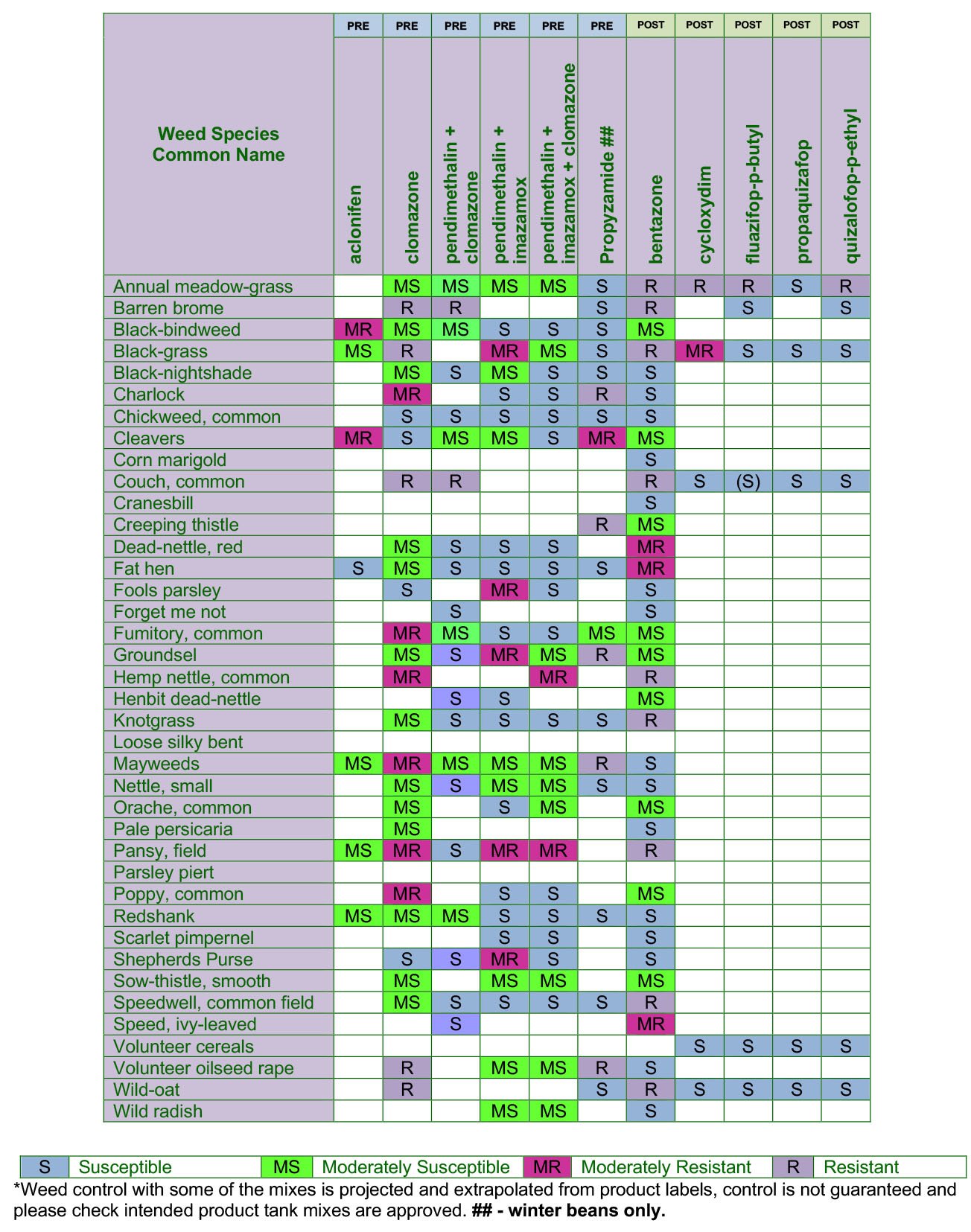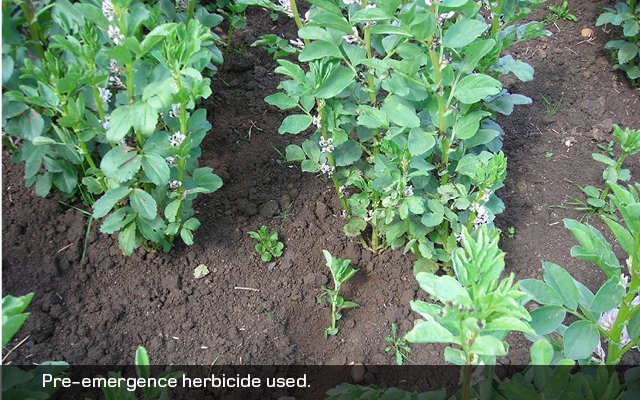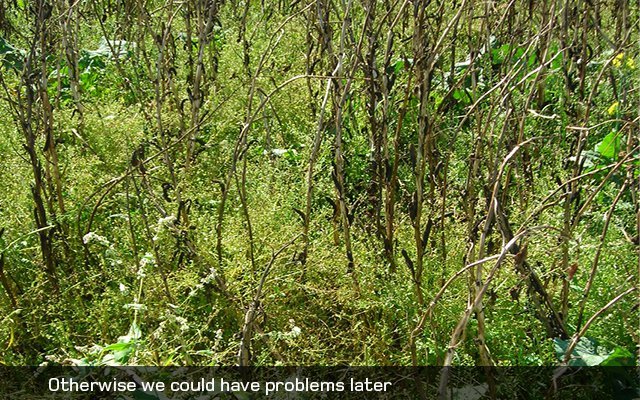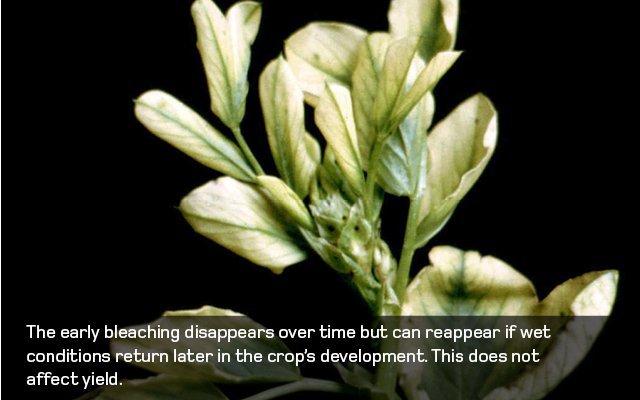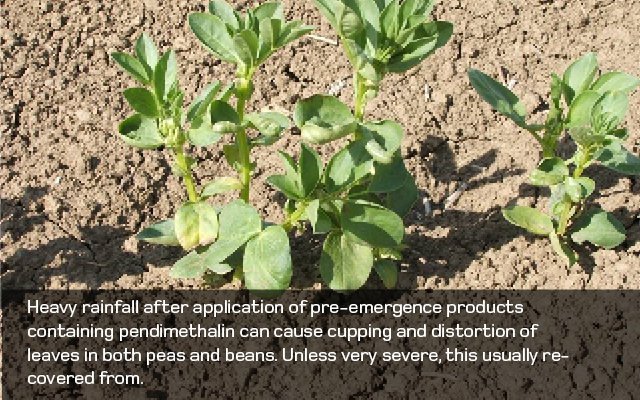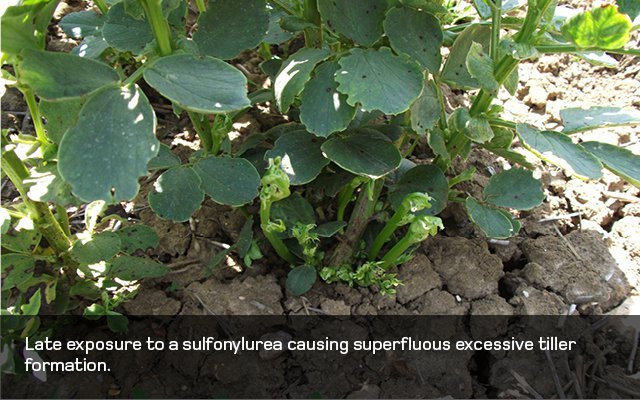 Full
FullGuide »
THIS SECTION CONSISTS OF GENERAL COMMENTS ON WEED CONTROL IN FIELD BEANS FOLLOWED BY DETAILS OF PRODUCTS/ACTIVE INGREDIENTS, WEED CONTROL CHECKLISTS AND A PHOTO SECTION WITH REFERENCE IMAGES OF WEEDS.
Weed infestations will reduce yield, and climbing species such as black-bindweed and cleavers can cause lodging.Effective weed control will ease combining. Several materials are available for controlling weeds in field beans and it is important that growers appreciate the properties of each and that they choose the one most suitable for their conditions, soil type and weed spectrum. These notes, partly based on the results of PGRO experimental work, are intended to help growers choose wisely.
For most pre-emergence bean herbicides there are recommendations that the land is ploughed or deep cultivated before sowing the following crop - please check the label.
Since there is only one approved post-emergence herbicide for field beans, it is essential to use a pre-emergence material where possible. Pre-emergence residual herbicides require soil moisture for activity. They are ineffective at economic rates on highly organic soils, and some are damaging on gravelly or very light soil types. They are less effective on cloddy seedbeds and rolling the seedbed will improve weed control with pre-emergence materials.
Winter bean crops are drilled, as well as established by shallowly ploughing seed down. Cultivation after spraying should be avoided - weed control will be reduced.
Thistles and docks are not controlled by herbicides for beans. Many perennial weeds may be eradicated with an appropriate glyphosate product pre-harvest of the preceding wheat or barley crop.
Possible tank-mixes have also been suggested which offer more flexibility. The weed control these mixes offer is based upon both experience and product labels.
At the end of this section there is a checklist of active ingredients and approved products for field beans, a checklist of weed problem & timing for field beans and a checklist of weed susceptibility to herbicides for field beans.
There is also a set of reference images of weeds relevant to field beans.
Propyzamide (e.g. Kerb & various other products) WB LERAP: n/a
This material controls germinating and established annual grasses including annual meadow-grass, black-grass, wild-oats, volunteer cereals, barren brome and some broad-leaved species including black-bindweed, fat-hen and knotgrass, up to 2 leaf stage. Germinating cleavers are also moderately susceptible. It must be applied within 7 days after drilling but before crop emergence (and between 1st October and 31st January). It performs best on soils of fine tilth and good structure in moist conditions and the seedbed must be firm before spraying. It is only for use on medium and heavy soils and not for soils with more than 10% organic matter. Kerb is insoluble and persists in the soil, so mouldboard ploughing must be carried out before sowing cereals or grasses as the following crop.
Clomazone (various products) WB, SB LERAP: n/a
A pre-emergence residual herbicide for the control of cleavers and broad-leaved weeds in beans. As well as cleavers it has good activity on chickweed, shepherds purse, fools parsley and red dead-nettle, but control of other species can be variable. It is best mixed with a partner product for a better spectrum of control. Centium is an effective tool if cleavers are predicted to be a problem. Bean leaves can become bleached after Centium application but providing the crop is not under any additional stress the symptoms should disappear with time and the yield left unaffected.
Nirvana (pendimethalin + imazamox) SB, WB LERAP: B
Nirvana can be used pre-emergence in spring and winter beans and provides wide spectrum residual broad-leaved weed control. Nirvana is crop safe on all commercially available bean varieties. Seed should be drilled to a depth of 25 mm and fields prone to water logging should be avoided.
Maximum persistence is seen with the full permitted dose of 4.5 l/ha and this may allow a ‘one-hit’ herbicide programme. The 3.0 l/ha application appears to be a good compromise with the additional option of perhaps a further drop to 2.5 l/ha when considering a mix with clomazone to maximise cleaver control. Work has shown the full 4.5 l/ha application reduced cleaver numbers effectively and may be a means of retaining the full weed control spectrum while still achieving adequate cleaver control. It shows excellent activity against polygonums, black-bindweed, redshank and knotgrass. Charlock is also effectively controlled as is chickweed. Nirvana also gives improved control of early emerging volunteer oilseed rape when compared to pendimethalin alone.
Stallion Sync TEC (pendimethalin + clomazone) SB and WB LERAP: B
A micro encapsulated formulation with useful activity on fat hen, speedwells, knotgrass field pansy and black nightshade.
Dual Gold (S-metolachlor) EAMU 20140163 can also now be used in spring beans between 1st March and 31st May. It has both broad and grass weed activity but will require a partner product.
All products used via EAMU’s are applied at the grower’s own risk.
Bentazone (e,g Basagran SG, Benta 480, Clayton Baritone) SB, WB LERAP: n/a
This is the only approved post-emergence treatment for field beans. Do not add adjuvant oils. It does not control a wide weed spectrum but is useful as a follow-up treatment to control cleavers and volunteer oilseed rape. It is most effective on small weeds and when applied in warm weather. A minimum of 6 hours free from rain is required after application. To avoid scorch the crop must be healthy, and at the correct stage of crop development (see label) and the temperature below 21°C. Beans at advanced stages of development are more susceptible to damage. Bentazone is an expensive herbicide if used at full rate for beans, and there are recommendations for split applications (see label for growth stages). Use the full dose rate for cleavers.
Please note, there have been changes to the Basagran SG label and rates of application altered. There is also advisory information regarding water stewardship with the aim of maximising product longevity. For the moment other bentazone product labels are as they were but please check.
OILSEED RAPE: Oilseed rape can be a problem weed several years after cropping. Allowing shed seed to germinate after harvest, before ploughing or deep cultivating will help prevent carry-over. Bentazone will control oilseed rape at early stages of growth.
Many of the approved post-emergence grass weed killers will not control annual meadow-grass. Propaquizafop will give some suppression of annual meadow-grass but only if applied up to 3 leaf stage.
Where this is used in sequence with other post-emergence treatments, care must be taken that the crop has recovered and is undamaged (see labels).
Falcon & other products (propaquizafop) SB, WB
Falcon is a post-emergence treatment for wild oats at optimum timings from two leaves folded to early tillering. Falcon may be applied to beans with two pairs of leaves until before crop flower buds are visible. Minimum harvest interval is 7 weeks. No adjuvant is needed, and it is rain-fast in one hour after application.
Fusilade Max & other product (fluazifop-p-butyl) SB, WB
This material is applied post-emergence. Fusilade Max requires no additional wetters. Other formulations may require appropriate wetters, check the label. Providing the wild-oats are actively growing, good control of well tillered plants is possible. Beans may be treated from second node stage onwards. Latest application stage is before bean flower buds visible. Check product labels for dose rates.
Laser & other products (cycloxydim) SB, WB
Laser + Toil adjuvant oil (at 0.5% final spray volume) is a post-emergence treatment for control of wild-oats and other grasses. Optimum timing for wild-oats is at two fully expanded leaves to the end of tillering. It may be applied from two bean leaf pairs until before the crop canopy prevents adequate spray penetration. It is very safe to the crop. Minimum harvest interval is 8 weeks for field beans.
Leopard 5 EC & other products (quizalofop-p-ethyl) SB, WB
It is a graminicide herbicide for the control of wild-oats and other grasses. Timing for wild-oats is from two leaves to fully tillered. It may be applied to beans before the crop canopy closes. Minimum harvest interval is 8 weeks.
Panarex (quizalafop-p-tefuryl) SB, WB
Is a post-emergence graminicide for the control of wild-oats and other grass weeds. Spring applications only are permitted but can be made from 2-3 unfolded leaves up to flower buds visible. It has a 60 day harvest interval.
Pre-emergence herbicides for broad-leaved weeds will have little effect on germinating black-grass. Where extensive germination is expected the most satisfactory control will be obtained by integrating cultural techniques and chemical options e.g Laser + Toil, Fusilade Max and, Falcon. A different approach will be needed where resistant black-grass occurs and specialist advice should be sought. To date no resistance to propyzamide (available in WB’s) has been detected.
Volunteer cereals can be controlled by the wild-oat rates of the post-emergence graminicides Fusilade Max (and others), Panarex, Leopard 5 EC or Falcon and at a slightly higher rate than for wild-oats with Laser.
The best and cheapest means of eradication is by application of Roundup (glyphosate) either pre-harvest in the previous cereal crop or in the autumn. Some control of this weed can be achieved by standard autumn cultivations or herbicide treatments.
Post-emergence Laser + Toil, Fusilade Max (and products containing fluazifop-p-butyl). Leopard 5 EC will give control of couch in the field bean crop and is applied when most couch shoots have emerged and are about 15 cm tall. Falcon is applied from 3 unfolded leaf stage when shoots are 15cm tall, Fusilade Max (and others) from 4 leaves when majority of shoots have emerged, Leopard 5 EC from 4 leaves to before jointing. Long term control should not be expected and at the higher rates suggested are usually uneconomic. Laser has a recommendation for control of onion couch. Roundup may also be used pre-harvest in field beans to eradicate couch and clean-up other problem weeds before the next crop is sown, but it cannot be used in seed crops.
There are label recommendations for control of barren brome using Laser, Fusilade Max, or Leopard 5 EC post-emergence. Trials show that Falcon is also effective.
Important notes:

# EAMU

